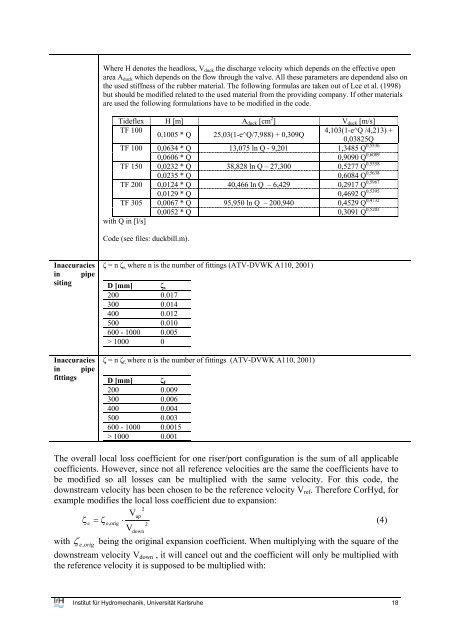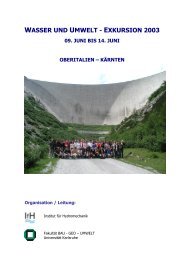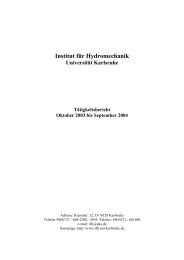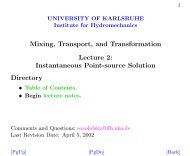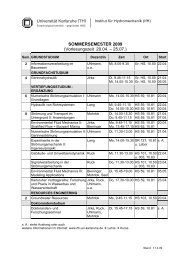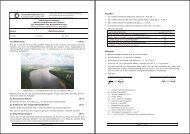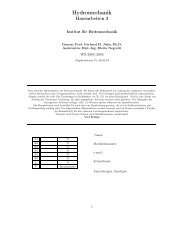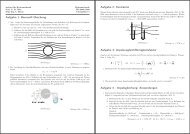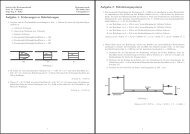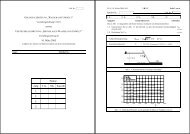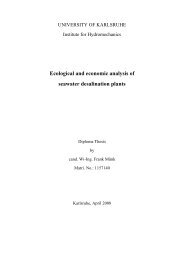user's manual for corhyd: an internal diffuser hydraulics model - IfH
user's manual for corhyd: an internal diffuser hydraulics model - IfH
user's manual for corhyd: an internal diffuser hydraulics model - IfH
You also want an ePaper? Increase the reach of your titles
YUMPU automatically turns print PDFs into web optimized ePapers that Google loves.
Where H denotes the headloss, V duck the discharge velocity which depends on the effective open<br />
area A duck which depends on the flow through the valve. All these parameters are dependend also on<br />
the used stiffness of the rubber material. The following <strong>for</strong>mulas are taken out of Lee et al. (1998)<br />
but should be modified related to the used material from the providing comp<strong>an</strong>y. If other materials<br />
are used the following <strong>for</strong>mulations have to be modified in the code.<br />
Tideflex H [m] A duck [cm 2 ] V duck [m/s]<br />
TF 100<br />
4,103(1-e^Q /4,213) +<br />
0,1005 * Q 25,03(1-e^Q/7,988) + 0,309Q<br />
0,03825Q<br />
TF 100 0,0634 * Q 13,075 ln Q - 9,201 1,3485 Q 0,5536<br />
0,0606 * Q 0,9090 Q 0,6089<br />
TF 150 0,0232 * Q 38,828 ln Q – 27,300 0,5277 Q 0,5558<br />
0,0235 * Q 0,6084 Q 0,5638<br />
TF 200 0,0124 * Q 40,466 ln Q – 6,429 0,2917 Q 0,5967<br />
0,0129 * Q 0,4692 Q 0,5395<br />
TF 305 0,0067 * Q 95,950 ln Q – 200,940 0,4529 Q 0,4732<br />
0,0052 * Q 0,3091 Q 0,5203<br />
with Q in [l/s]<br />
Code (see files: duckbill.m).<br />
Inaccuracies<br />
in pipe<br />
siting<br />
Inaccuracies<br />
in pipe<br />
fittings<br />
ζ = n ζ s, where n is the number of fittings (ATV-DVWK A110, 2001)<br />
D [mm] ζ s<br />
200 0.017<br />
300 0.014<br />
400 0.012<br />
500 0.010<br />
600 - 1000 0.005<br />
> 1000 0<br />
ζ = n ζ f, where n is the number of fittings (ATV-DVWK A110, 2001)<br />
D [mm] ζ f<br />
200 0.009<br />
300 0.006<br />
400 0.004<br />
500 0.003<br />
600 - 1000 0.0015<br />
> 1000 0.001<br />
The overall local loss coefficient <strong>for</strong> one riser/port configuration is the sum of all applicable<br />
coefficients. However, since not all reference velocities are the same the coefficients have to<br />
be modified so all losses c<strong>an</strong> be multiplied with the same velocity. For this code, the<br />
downstream velocity has been chosen to be the reference velocity V ref . There<strong>for</strong>e CorHyd, <strong>for</strong><br />
example modifies the local loss coefficient due to exp<strong>an</strong>sion:<br />
2<br />
Vup<br />
ζ<br />
e<br />
= ζ<br />
e,orig<br />
⋅<br />
(4)<br />
2<br />
V<br />
down<br />
with ζ being the original exp<strong>an</strong>sion coefficient. When multiplying with the square of the<br />
e, orig<br />
downstream velocity V down , it will c<strong>an</strong>cel out <strong>an</strong>d the coefficient will only be multiplied with<br />
the reference velocity it is supposed to be multiplied with:<br />
Institut für Hydromech<strong>an</strong>ik, Universität Karlsruhe 18


